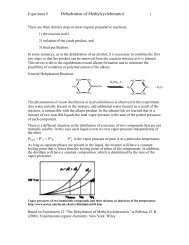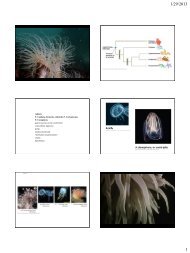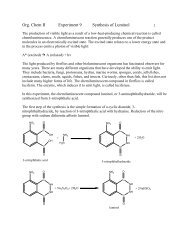A Solvent-Free Oxidation of Alcohols in an Organic Laboratory
A Solvent-Free Oxidation of Alcohols in an Organic Laboratory
A Solvent-Free Oxidation of Alcohols in an Organic Laboratory
- No tags were found...
You also want an ePaper? Increase the reach of your titles
YUMPU automatically turns print PDFs into web optimized ePapers that Google loves.
In the <strong>Laboratory</strong>A <strong>Solvent</strong>-<strong>Free</strong> <strong>Oxidation</strong> <strong>of</strong> <strong>Alcohols</strong><strong>in</strong> <strong>an</strong> Org<strong>an</strong>ic <strong>Laboratory</strong>WJohn J. Esteb,* Michael W. Schelle, <strong>an</strong>d Anne M. WilsonDepartment <strong>of</strong> Chemistry, Butler University, Indi<strong>an</strong>apolis, IN 46208; *jesteb@butler.eduChemical oxidations <strong>of</strong> alcohols are widely utilized <strong>in</strong>org<strong>an</strong>ic synthesis (1) <strong>an</strong>d are rout<strong>in</strong>ely covered <strong>in</strong> org<strong>an</strong>icchemistry textbooks. Unfortunately, few experiments havebeen developed for the undergraduate laboratory <strong>in</strong>volv<strong>in</strong>gthe chemical oxidation <strong>of</strong> alcohols (2). Among the publishedprocedures for the undergraduate laboratory, most <strong>in</strong>volve theuse <strong>of</strong> hypochlorite solutions (2a–c) as the oxidizer or Cr(VI)-based supported oxidiz<strong>in</strong>g reagents (2d–f). This lack <strong>of</strong> experimentsis most likely due to the <strong>in</strong>herent toxicity <strong>an</strong>ddisposal costs <strong>of</strong> most <strong>of</strong> the oxidiz<strong>in</strong>g reagents used to accomplishthese tr<strong>an</strong>sformations.Recently, Shaab<strong>an</strong>i <strong>an</strong>d Lee (3) have reported a procedurefor the solvent-free oxidation <strong>of</strong> thiols, sulfides, diols,<strong>an</strong>d alcohols us<strong>in</strong>g a mixture <strong>of</strong> KMnO 4 <strong>an</strong>d CuSO 4 5H 2 O.The relatively low toxicity <strong>an</strong>d availability <strong>of</strong> the oxidiz<strong>in</strong>greagent (4) coupled with the simplicity <strong>of</strong> their procedureled us to <strong>in</strong>vestigate the possibility <strong>of</strong> convert<strong>in</strong>g their oxidationprocess <strong>in</strong>to a form applicable to the teach<strong>in</strong>g laboratory.The oxidation <strong>of</strong> alcohols to ketones under solvent-free conditions(5) has not yet been utilized <strong>in</strong> the undergraduateteach<strong>in</strong>g laboratory. However, there has been one laboratoryexercise reported <strong>in</strong> this Journal (2g) detail<strong>in</strong>g the oxidation<strong>of</strong> benzo<strong>in</strong> to benzil us<strong>in</strong>g alum<strong>in</strong>a-supported active MnO 2 .Though this reaction <strong>in</strong>volves a solvent-free, supported oxid<strong>an</strong>t,the reaction takes place <strong>in</strong> CH 2 Cl 2 over a 2-hour period.The laboratory we have developed <strong>of</strong>fers several adv<strong>an</strong>tagesover m<strong>an</strong>y <strong>of</strong> the exist<strong>in</strong>g exercises <strong>in</strong>volv<strong>in</strong>g chemical oxidations<strong>in</strong>clud<strong>in</strong>g lower toxicity <strong>of</strong> the reagents (relative toCr(VI) species), environmental friendl<strong>in</strong>ess, the ability to reducethe amount <strong>of</strong> waste generated <strong>an</strong>d hazardous materialsused, <strong>an</strong>d the overall cost effectiveness <strong>of</strong> the reactions. All<strong>of</strong> these adv<strong>an</strong>tages are import<strong>an</strong>t considerations <strong>in</strong> the development<strong>an</strong>d implementation <strong>of</strong> a new teach<strong>in</strong>g laboratory.In this experiment, a ground mixture <strong>of</strong> KMnO 4 <strong>an</strong>dCuSO 4 5H 2 O was used to oxidize a series <strong>of</strong> secondary alcoholsto their correspond<strong>in</strong>g ketones under solvent-free conditions(Scheme I). Cyclohex<strong>an</strong>ol (1a), 2-oct<strong>an</strong>ol (2a), <strong>an</strong>dbenzhydrol (3a) were selected as suitable alcohols ow<strong>in</strong>g totheir low cost, low toxicity, <strong>an</strong>d for their ability to be completelyoxidized <strong>in</strong> a one-hour time period. Th<strong>in</strong>-layer chromatography(TLC) was used to monitor the reaction’sprogress. Furthermore, s<strong>in</strong>ce the reaction yields were nearqu<strong>an</strong>titative, the students obta<strong>in</strong>ed enough material to characterizetheir product by NMR, GC–MS, or IR.Experimental ProcedureA powdered mixture <strong>of</strong> the oxid<strong>an</strong>t was prepared bygr<strong>in</strong>d<strong>in</strong>g 1.58 g (10.0 mmol) <strong>of</strong> KMnO 4 with 2.50 g (10.0mmol) <strong>of</strong> CuSO 4 5H 2 O with a mortar <strong>an</strong>d pestle until themixture was visually homogeneous. The alcohol (1a, 2a, or3a) (4.82 mmol) was added to a 25-mL round bottom flask,followed by the addition <strong>of</strong> ca. 4 g (10 mmol) <strong>of</strong> the oxid<strong>an</strong>tmixture. The result<strong>in</strong>g reaction mixture was stirred vigorouslywith a spatula until the flask beg<strong>an</strong> to become warm <strong>in</strong>dicat<strong>in</strong>g<strong>in</strong>itiation <strong>of</strong> the exothermic reaction. A reflux condenserwas immediately attached <strong>an</strong>d the flask was placed <strong>in</strong> a preheatedhot water or steam bath at ca. 100 C. After 1 h, thereaction was complete. The mixture was cooled to room temperature<strong>an</strong>d desorbed from the solid reaction byproduct withtwo 10-mL portions <strong>of</strong> hex<strong>an</strong>e. The hex<strong>an</strong>e solution was suctionfiltered. Dry<strong>in</strong>g <strong>of</strong> the filtrate with MgSO 4 , gravity filtration,<strong>an</strong>d evaporation <strong>of</strong> the solvent produced the desiredketone (1b, 2b, or 3b) <strong>in</strong> near qu<strong>an</strong>titative yield. TLC <strong>an</strong>alysisus<strong>in</strong>g 5:1 hex<strong>an</strong>e:ethyl acetate as the elution solvent confirmedthat the alcohol had been consumed. 1 Comparisonwas also made between the <strong>in</strong>frared spectra <strong>of</strong> the start<strong>in</strong>gmaterial <strong>an</strong>d the product. 2HazardsPotassium perm<strong>an</strong>g<strong>an</strong>ate is a potent oxidiz<strong>in</strong>g agent. 3Care should be taken when used <strong>in</strong> conjunction with org<strong>an</strong>icmaterials <strong>an</strong>d strong acids. Thermal decomposition may yieldtoxic fumes <strong>of</strong> m<strong>an</strong>g<strong>an</strong>ese oxides. Keep reaction temperatureat 100 C or below to help to avoid thermal decomposition.Hex<strong>an</strong>e is a flammable solvent. Further health <strong>an</strong>d safetynotes may be found <strong>in</strong> the Supplemental Material. W Safetyglasses should be worn at all times.HOHH OH OKMnO 4 / CuSO 4H2a3aOH1aKMnO 4 / CuSO 41 h1 hKMnO 4 / CuSO 41 hScheme I. <strong>Oxidation</strong> <strong>of</strong> secondary alcohols to their correspond<strong>in</strong>gketones under solvent-free conditions.O1b2bO3bJChemEd.chem.wisc.edu • Vol. 80 No. 8 August 2003 • Journal <strong>of</strong> Chemical Education 907
In the <strong>Laboratory</strong>AcknowledgmentThe authors would like to th<strong>an</strong>k Butler University’s 2002summer org<strong>an</strong>ic chemistry classes for assist<strong>an</strong>ce with thepreparation <strong>an</strong>d test<strong>in</strong>g <strong>of</strong> this lab. The authors would alsolike to th<strong>an</strong>k Stacy O’Reilly for helpful discussions.W Supplemental MaterialInstructions for the students <strong>an</strong>d notes for the <strong>in</strong>structorare available <strong>in</strong> this issue <strong>of</strong> JCE Onl<strong>in</strong>e.Notes1. It may be necessary to develop the TLC plates <strong>in</strong> <strong>an</strong> iod<strong>in</strong>echamber.2. Incorporation <strong>of</strong> <strong>in</strong>frared spectroscopy <strong>in</strong>to this laboratoryworks well as students c<strong>an</strong> clearly see the ch<strong>an</strong>ge from the spectra<strong>of</strong> the start<strong>in</strong>g alcohol to the result<strong>in</strong>g ketone.3. It may be necessary to decompose excess perm<strong>an</strong>g<strong>an</strong>ate bygently heat<strong>in</strong>g the reaction byproduct with 10 mL <strong>of</strong> ethyl alcohol.Literature Cited1. For books on oxidation reactions, see (a) Hudlicky, M. <strong>Oxidation</strong>s<strong>in</strong> Org<strong>an</strong>ic Chemistry; ACS Monograph 186; Americ<strong>an</strong>Chemical Society: Wash<strong>in</strong>gton DC, 1990. (b) Ha<strong>in</strong>es, A.H. Methods for the <strong>Oxidation</strong> <strong>of</strong> Org<strong>an</strong>ic Compounds; AcademicPress: New York, 1985, 1988; 2 vols. (c) Ch<strong>in</strong>n, L. J. Selection<strong>of</strong> Oxid<strong>an</strong>ts <strong>in</strong> Synthesis; Marcel Dekker: New York, 1971.(d) <strong>Oxidation</strong>; August<strong>in</strong>e, R. L., Trecker, D. J., Eds.; MarcelDekker: New York, 1969, 1971; 2 vols.2. (a) McDonald, C. E. J. Chem. Educ. 2000, 77, 750. (b)Shadwick, S. R.; Moh<strong>an</strong>, R. S. J. Chem. Educ. 1999, 76, 1121.(c) Hill, J. W.; Jenson, J. A.; Henkew, C. F.; Yaritz, J. G.;Pederson, R. L. J. Chem. Educ. 1984, 61, 1118. (d) Luzzio, F.A.; Fitch, R. W.; Moore, W. J.; Mudd, K. J. J. Chem. Educ.1999, 76, 974. (e) Taber, D. F.; W<strong>an</strong>g, Y.; Liehr, S. J. Chem.Educ. 1996, 73, 1042. (f) Burglass, A. J.; Waterhouse, J. S. J.Chem. Educ. 1987, 64, 371. (g) Crouch, R. D.; Holden, M.S.; Burger, J. S. J. Chem. Educ. 2001, 78, 951. (h) Yohe, G.R.; Louder, H. U.; Smith, G. A. J. Chem. Educ. 1933, 10,374. (i) Hart, H.; Reilly, J. L. J. Chem. Educ. 1978, 55, 120.3. Shaab<strong>an</strong>i, A.; Lee, D. G. Tetrahedron Lett. 2001, 42, 5833.4. S<strong>in</strong>gh, N.; Lee, D. G. Org. Process. Res. Dev. 2001, 5, 559.(b) Gossel<strong>in</strong>, R. E.; Hodge, H. C.; Smith, R. P.; Gleason, M.N. Cl<strong>in</strong>ical Toxicology <strong>of</strong> Commercial Products, 4th ed.; Williams& Wilk<strong>in</strong>s: Baltimore, MD, 1976.5. (a) Firouzabadi, H.; Abbassi, M.; Karimi, B. Synth. Commun.1999, 29, 2527. (b) Guibe-Jampel, E.; Therisod, M. J. Chem.Soc., Perk<strong>in</strong> Tr<strong>an</strong>s. 1 1999, 3067. (c) Sa<strong>in</strong>te-Marie, L.; Guibe-Jampel, E.; Therisod, M. Tetrahedron Lett. 1998, 39, 9661.(d) Varma, R. S.; Dahiya, R. Synth. Commun. 1998, 28, 4087.(e) Firouzabadi, H.; Abbassi, M. Synth. Commun. 1999, 29,1485. (f) Kropp, P. J.; Breton, G. W.; Fields, J. D.; Tung, J.C.; Loomis, B. R. J. Am. Chem. Soc. 2000, 122, 4280. (g)Fields, J. D.; Kropp, P. J. J. Org. Chem. 2000, 65, 5937. (h)Oussaid, A.; Loupy, A. J. Chem. Res., Synop. 1997, No. 9, 342.(i) Benhaliliba, H. Derdour, A.; Bazureau, J.-P.; Texier-Boullet,F.; Hamel<strong>in</strong>, J. Tetrahedron Lett. 1998, 39, 541. (j)V<strong>an</strong>kelecom, I.; Vercruysse, K.; Moens, N.; Parton, R.; Reddy,J. S.; Jacobs, P. Chem. Commun. 1997, 137. (k) Firouzabadi,H.; Karimi, B.; Abbassi, M. J. Chem. Res., Synop. 1999, No.3, 236. (l) Mart<strong>in</strong>ez, L. A.; Garcia, O.; Delgado, F.; Alvarez,C.; Pat<strong>in</strong>o, R. Tetrahedron Lett. 1993, 34, 5293.908 Journal <strong>of</strong> Chemical Education • Vol. 80 No. 8 August 2003 • JChemEd.chem.wisc.edu
















